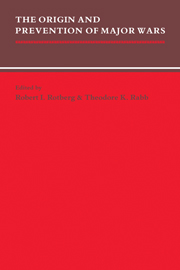Book contents
- Frontmatter
- Contents
- Introduction
- The Origins of War: Structural Theories
- The Origins of War: Explanation of Non-rational Causality
- Lessons and Analogies from Early Major Wars
- Ideology and Conflict: The Wars of the Ottoman Empire, 1453–1606
- The Origins of the Thirty Years' War
- The Origins, Causes, and Extension of the Wars of the French Revolution and Napoleon
- Lessons and Analogies from the World Wars
The Origins of the Thirty Years' War
Published online by Cambridge University Press: 02 December 2009
- Frontmatter
- Contents
- Introduction
- The Origins of War: Structural Theories
- The Origins of War: Explanation of Non-rational Causality
- Lessons and Analogies from Early Major Wars
- Ideology and Conflict: The Wars of the Ottoman Empire, 1453–1606
- The Origins of the Thirty Years' War
- The Origins, Causes, and Extension of the Wars of the French Revolution and Napoleon
- Lessons and Analogies from the World Wars
Summary
Among the major wars of modern European history, the Thirty Years' War stands out not only for its duration but also for its striking impact on the international system in which it took place. Before 1618, the Spanish Habsburgs were the central power in a Europe where religious differences were crucial. The war and its Franco-Spanish extension ended in 1659. By that time, France and other nations had increased their power, and religion played a much less important role in defining alliances. Moreover, Europe's center had moved east, as Russia, Prussia, and the Austrian Habsburgs became more powerful.
The war's origins are well known. Conflict in the Holy Roman Empire, especially in the Habsburg lands, over religion and over the power of the emperor provoked a civil war in Bohemia in 1618. The Bohemian war both resurrected and created a network of alliances which caused the conflict to continue into the 1620s. The opportunities offered by the disruption in Germany led the Danes to invade in 1625, and the Swedes and French to intervene in the 1630s, which continued the war by bringing in fresh combatants. The result was a conflict that could not be controlled by the Bohemians and the emperor, who had begun it. They were not allowed to extricate themselves until they had completely exhausted themselves and everyone else; as fitting compensation, the Bohemians and the emperor were important losers.
- Type
- Chapter
- Information
- The Origin and Prevention of Major Wars , pp. 177 - 198Publisher: Cambridge University PressPrint publication year: 1989



